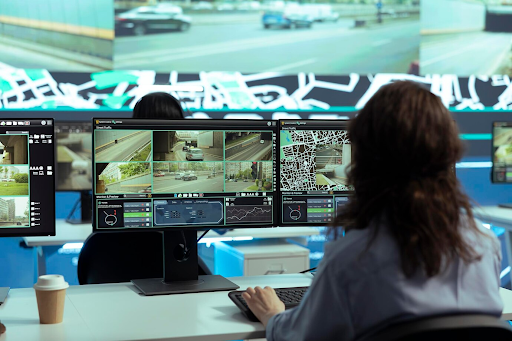CCTV Footage as Evidence in Criminal Investigations?
Retail Loss Prevention Series
CCTV Footage as Evidence in Criminal Investigations?

I. Introduction
In the realm of modern criminal investigations, Closed-Circuit Television (CCTV) has emerged as an invaluable tool. Its widespread presence in public spaces and private properties alike has transformed how law enforcement agencies gather evidence and solve crimes. From bustling city streets to quiet suburban neighborhoods, CCTV cameras are ever-watchful, capturing crucial moments that can make or break a case. As technology advances, the role of CCTV in criminal investigations continues to expand, offering new possibilities for enhancing public safety and justice.
II. Importance of CCTV in Solving Crimes
CCTV footage plays a pivotal role in expediting suspect identification and establishing crucial timelines in criminal investigations. The visual evidence captured by these cameras can provide law enforcement with immediate insights into the sequence of events, aiding in the swift apprehension of suspects. For instance, in cases of assaults and robberies, CCTV footage can offer clear images of the perpetrators, their actions, and their escape routes, significantly narrowing down the list of potential suspects (Pinkerton, 2022).
Case studies abound that illustrate the transformative impact of CCTV evidence on investigation outcomes. In one notable instance, CCTV footage was instrumental in solving a high-profile robbery case, where the visual evidence not only identified the culprits but also provided a timeline that corroborated witness statements, leading to a successful prosecution.
III. Types of Evidence CCTV Provides
CCTV footage serves as both direct and circumstantial evidence in criminal investigations. As direct evidence, it offers visual proof of events as they unfold, capturing the actions of suspects in real-time. This type of evidence is particularly compelling in court, as it allows juries to witness the crime as it happened.
In addition to direct evidence, CCTV footage provides circumstantial evidence that supports other elements of the investigation. Time-stamps and location data from the footage help corroborate witness testimonies and fill gaps in accounts, creating a more comprehensive picture of the crime (Australian Institute of Criminology, 2024). This dual role enhances the evidentiary value of CCTV, making it a cornerstone of modern investigative practices.
IV. Challenges in Using CCTV Footage
Despite its advantages, the use of CCTV footage in criminal investigations is not without challenges. Quality issues, such as variations in resolution, lighting, and camera angles, can impact the clarity of the footage, potentially hindering identification efforts. Furthermore, the sheer volume of data generated by CCTV systems poses storage and retrieval challenges, particularly when incidents span multiple locations.
Privacy concerns also arise, as the balance between surveillance and individual rights must be carefully managed, especially in public spaces. Situational limitations, such as the absence of cameras in certain locations or obstructed views, can further complicate the use of CCTV footage as evidence.
V. Legal Considerations
The admissibility of CCTV footage in court hinges on several legal considerations. For the footage to be accepted as evidence, it must meet criteria such as clear identification and an unaltered state. The chain of custody is another critical aspect, as secure handling and storage are essential to avoid tampering claims.
Jurisdictional differences in laws governing CCTV usage and admissibility add another layer of complexity. What is permissible in one region may not be acceptable in another, necessitating a thorough understanding of local legal frameworks when utilizing CCTV footage in criminal proceedings.
VI. Best Practices for Law Enforcement
To maximize the utility of CCTV footage in criminal investigations, law enforcement agencies must adhere to best practices in retrieving and preserving evidence. Officers should follow established guidelines for collecting and handling CCTV footage to ensure its integrity and admissibility in court.
Advances in forensic video analysis technology offer new opportunities to enhance footage clarity and utility. Techniques such as image stabilization and enhancement can improve the quality of the evidence, making it more persuasive in legal proceedings.
Interagency collaboration is also crucial, as sharing CCTV footage across agencies, such as public transit and police departments, can help track suspects across multiple locations, providing a more comprehensive view of their activities.
VII. Frequently Asked Questions
- What type of evidence is CCTV footage? CCTV footage serves as both direct and circumstantial evidence, providing visual proof of events and supporting other elements of an investigation.
- Is CCTV footage enough to convict someone? While CCTV footage can be compelling, it is typically used in conjunction with other evidence to build a strong case for conviction.
- How long is CCTV footage kept for criminal investigations? The retention period for CCTV footage varies by jurisdiction and organization, but it is generally kept for a specified duration to support ongoing investigations.
- Can CCTV footage be used as evidence in court? Yes, CCTV footage can be used as evidence in court, provided it meets legal criteria for admissibility, such as clear identification and an unaltered state.
- How effective is CCTV in preventing crime? CCTV can deter criminal activity by increasing the perceived risk of detection, but its effectiveness varies depending on factors such as camera placement and visibility.
VIII. Conclusion
CCTV footage has become an indispensable asset in criminal investigations, offering both benefits and limitations. Its ability to provide direct and circumstantial evidence makes it a powerful tool for law enforcement, while challenges such as quality issues and privacy concerns must be carefully managed. As technology continues to evolve, innovations such as AI-enhanced video analysis hold the potential to further enhance the role of CCTV in law enforcement, paving the way for more effective and efficient criminal investigations. By embracing these advancements and adhering to best practices, law enforcement agencies can harness the full potential of CCTV to enhance public safety and justice.







